engine FIAT STRADA 2012 Owner handbook (in English)
[x] Cancel search | Manufacturer: FIAT, Model Year: 2012, Model line: STRADA, Model: FIAT STRADA 2012Pages: 187, PDF Size: 8.06 MB
Page 99 of 187
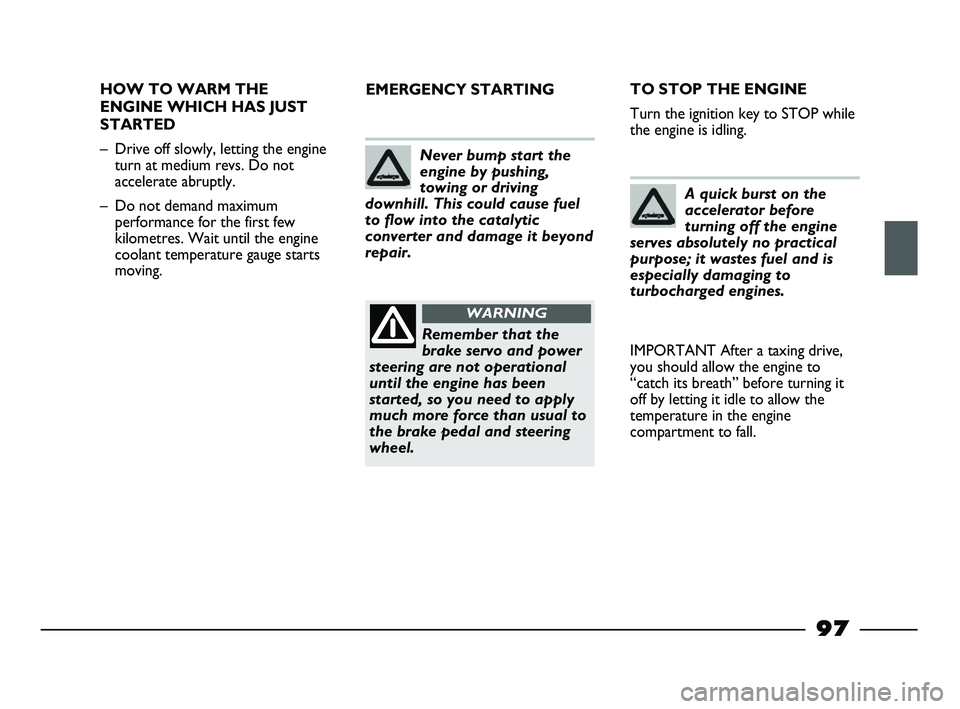
97
HOW TO WARM THE
ENGINE WHICH HAS JUST
STARTED
– Drive off slowly, letting the engine
turn at medium revs. Do not
accelerate abruptly.
– Do not demand maximum
performance for the first few
kilometres. Wait until the engine
coolant temperature gauge starts
moving.EMERGENCY STARTING
Never bump start the
engine by pushing,
towing or driving
downhill. This could cause fuel
to flow into the catalytic
converter and damage it beyond
repair.
Remember that the
brake servo and power
steering are not operational
until the engine has been
started, so you need to apply
much more force than usual to
the brake pedal and steering
wheel.
WARNING
TO STOP THE ENGINE
Turn the ignition key to STOP while
the engine is idling.
A quick burst on the
accelerator before
turning off the engine
serves absolutely no practical
purpose; it wastes fuel and is
especially damaging to
turbocharged engines.
IMPORTANT After a taxing drive,
you should allow the engine to
“catch its breath” before turning it
off by letting it idle to allow the
temperature in the engine
compartment to fall.
095-106 STRADA LUM GB 1ed 9-01-2012 14:51 Pagina 97
Page 100 of 187
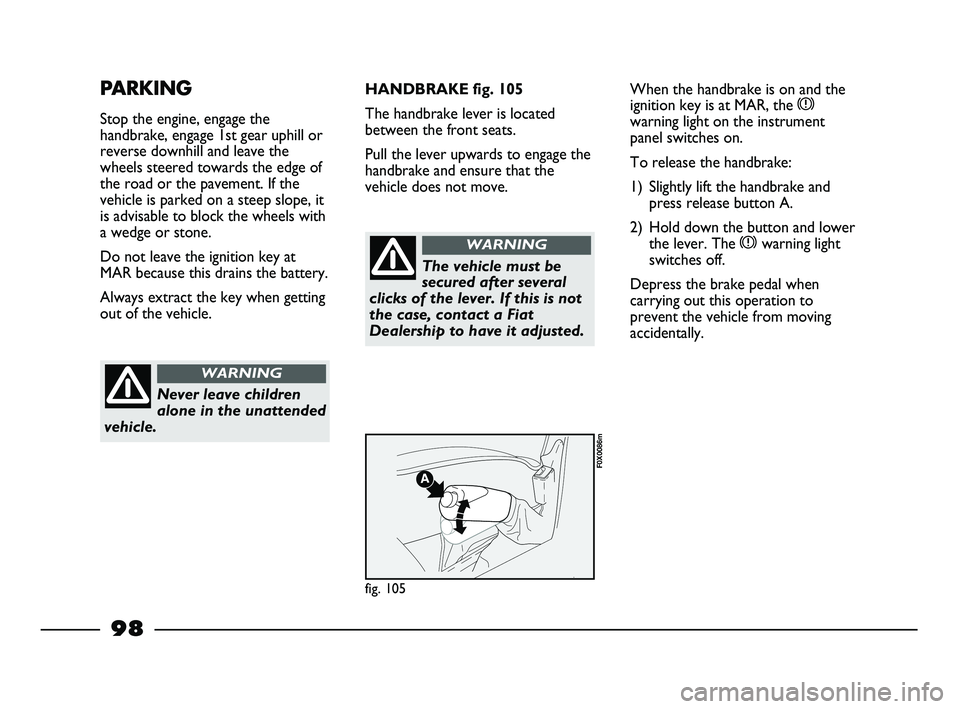
98
PARKING
Stop the engine, engage the
handbrake, engage 1st gear uphill or
reverse downhill and leave the
wheels steered towards the edge of
the road or the pavement. If the
vehicle is parked on a steep slope, it
is advisable to block the wheels with
a wedge or stone.
Do not leave the ignition key at
MAR because this drains the battery.
Always extract the key when getting
out of the vehicle.
Never leave children
alone in the unattended
vehicle.
WARNING
HANDBRAKE fig. 105
The handbrake lever is located
between the front seats.
Pull the lever upwards to engage the
handbrake and ensure that the
vehicle does not move.When the handbrake is on and the
ignition key is at MAR, the x
warning light on the instrument
panel switches on.
To release the handbrake:
1) Slightly lift the handbrake and
press release button A.
2) Hold down the button and lower
the lever. The xwarning light
switches off.
Depress the brake pedal when
carrying out this operation to
prevent the vehicle from moving
accidentally.
The vehicle must be
secured after several
clicks of the lever. If this is not
the case, contact a Fiat
Dealership to have it adjusted.
WARNING
fig. 105
F0X0086m
095-106 STRADA LUM GB 1ed 9-01-2012 14:51 Pagina 98
Page 101 of 187
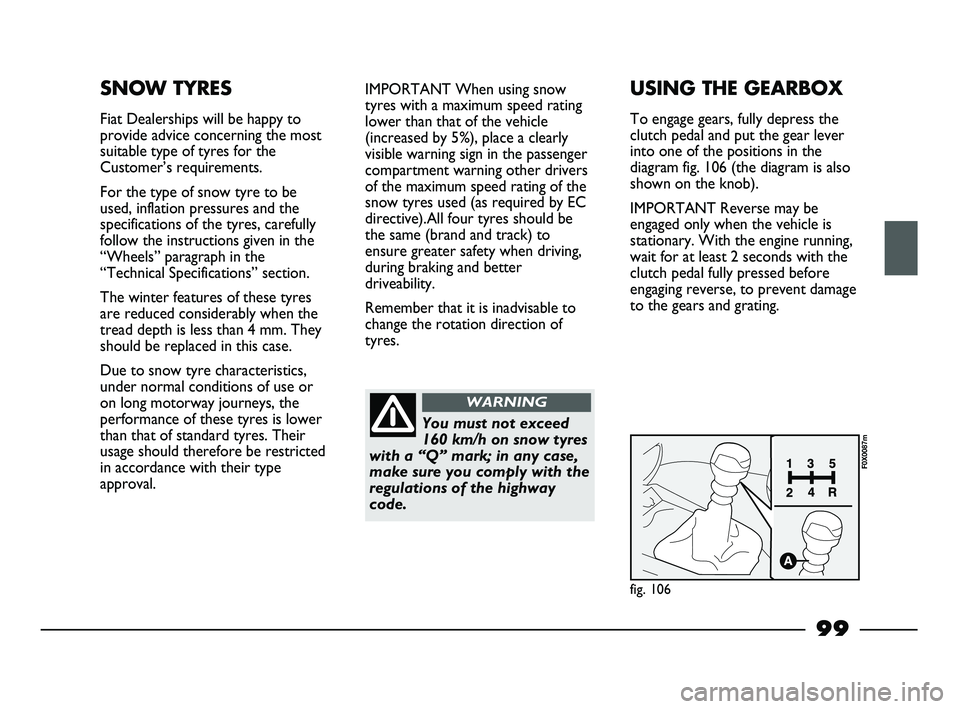
99
SNOW TYRES
Fiat Dealerships will be happy to
provide advice concerning the most
suitable type of tyres for the
Customer’s requirements.
For the type of snow tyre to be
used, inflation pressures and the
specifications of the tyres, carefully
follow the instructions given in the
“Wheels” paragraph in the
“Technical Specifications” section.
The winter features of these tyres
are reduced considerably when the
tread depth is less than 4 mm. They
should be replaced in this case.
Due to snow tyre characteristics,
under normal conditions of use or
on long motorway journeys, the
performance of these tyres is lower
than that of standard tyres. Their
usage should therefore be restricted
in accordance with their type
approval.IMPORTANT When using snow
tyres with a maximum speed rating
lower than that of the vehicle
(increased by 5%), place a clearly
visible warning sign in the passenger
compartment warning other drivers
of the maximum speed rating of the
snow tyres used (as required by EC
directive).All four tyres should be
the same (brand and track) to
ensure greater safety when driving,
during braking and better
driveability.
Remember that it is inadvisable to
change the rotation direction of
tyres.
USING THE GEARBOX
To engage gears, fully depress the
clutch pedal and put the gear lever
into one of the positions in the
diagram fig. 106 (the diagram is also
shown on the knob).
IMPORTANT Reverse may be
engaged only when the vehicle is
stationary. With the engine running,
wait for at least 2 seconds with the
clutch pedal fully pressed before
engaging reverse, to prevent damage
to the gears and grating.
You must not exceed
160 km/h on snow tyres
with a “Q” mark; in any case,
make sure you comply with the
regulations of the highway
code.
WARNING
fig. 106
F0X0087m
095-106 STRADA LUM GB 1ed 9-01-2012 14:51 Pagina 99
Page 105 of 187
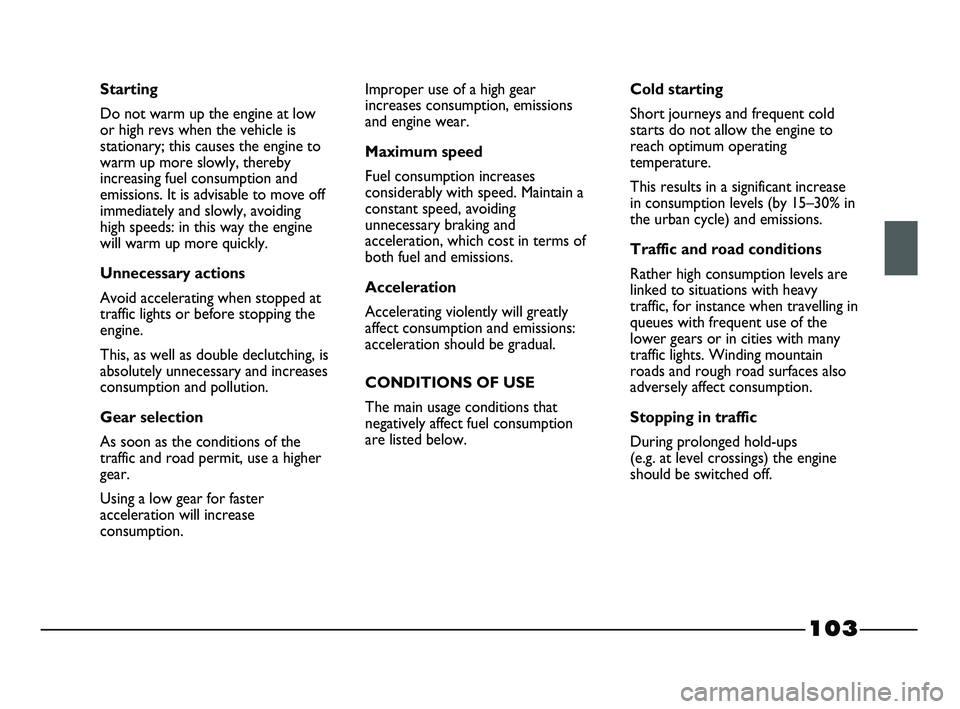
103
Starting
Do not warm up the engine at low
or high revs when the vehicle is
stationary; this causes the engine to
warm up more slowly, thereby
increasing fuel consumption and
emissions. It is advisable to move off
immediately and slowly, avoiding
high speeds: in this way the engine
will warm up more quickly.
Unnecessary actions
Avoid accelerating when stopped at
traffic lights or before stopping the
engine.
This, as well as double declutching, is
absolutely unnecessary and increases
consumption and pollution.
Gear selection
As soon as the conditions of the
traffic and road permit, use a higher
gear.
Using a low gear for faster
acceleration will increase
consumption.Improper use of a high gear
increases consumption, emissions
and engine wear.
Maximum speed
Fuel consumption increases
considerably with speed. Maintain a
constant speed, avoiding
unnecessary braking and
acceleration, which cost in terms of
both fuel and emissions.
Acceleration
Accelerating violently will greatly
affect consumption and emissions:
acceleration should be gradual.
CONDITIONS OF USE
The main usage conditions that
negatively affect fuel consumption
are listed below.Cold starting
Short journeys and frequent cold
starts do not allow the engine to
reach optimum operating
temperature.
This results in a significant increase
in consumption levels (by 15–30% in
the urban cycle) and emissions.
Traffic and road conditions
Rather high consumption levels are
linked to situations with heavy
traffic, for instance when travelling in
queues with frequent use of the
lower gears or in cities with many
traffic lights. Winding mountain
roads and rough road surfaces also
adversely affect consumption.
Stopping in traffic
During prolonged hold-ups
(e.g. at level crossings) the engine
should be switched off.
095-106 STRADA LUM GB 1ed 9-01-2012 14:51 Pagina 103
Page 107 of 187
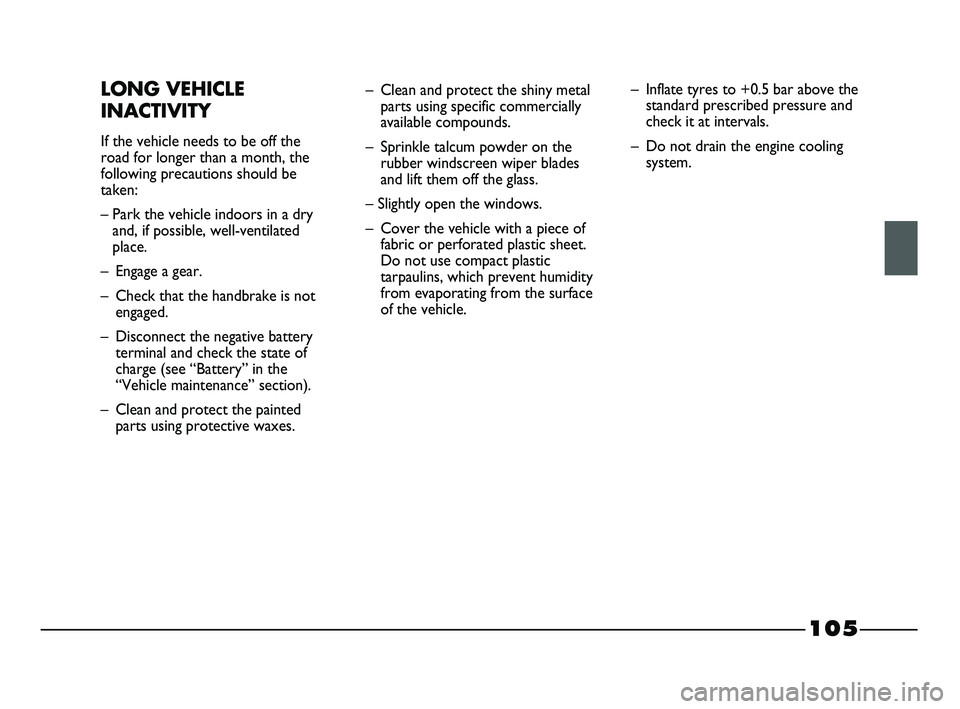
105
LONG VEHICLE
INACTIVITY
If the vehicle needs to be off the
road for longer than a month, the
following precautions should be
taken:
– Park the vehicle indoors in a dry
and, if possible, well-ventilated
place.
– Engage a gear.
– Check that the handbrake is not
engaged.
– Disconnect the negative battery
terminal and check the state of
charge (see “Battery” in the
“Vehicle maintenance” section).
– Clean and protect the painted
parts using protective waxes.– Clean and protect the shiny metal
parts using specific commercially
available compounds.
– Sprinkle talcum powder on the
rubber windscreen wiper blades
and lift them off the glass.
– Slightly open the windows.
– Cover the vehicle with a piece of
fabric or perforated plastic sheet.
Do not use compact plastic
tarpaulins, which prevent humidity
from evaporating from the surface
of the vehicle.– Inflate tyres to +0.5 bar above the
standard prescribed pressure and
check it at intervals.
– Do not drain the engine cooling
system.
095-106 STRADA LUM GB 1ed 9-01-2012 14:51 Pagina 105
Page 109 of 187
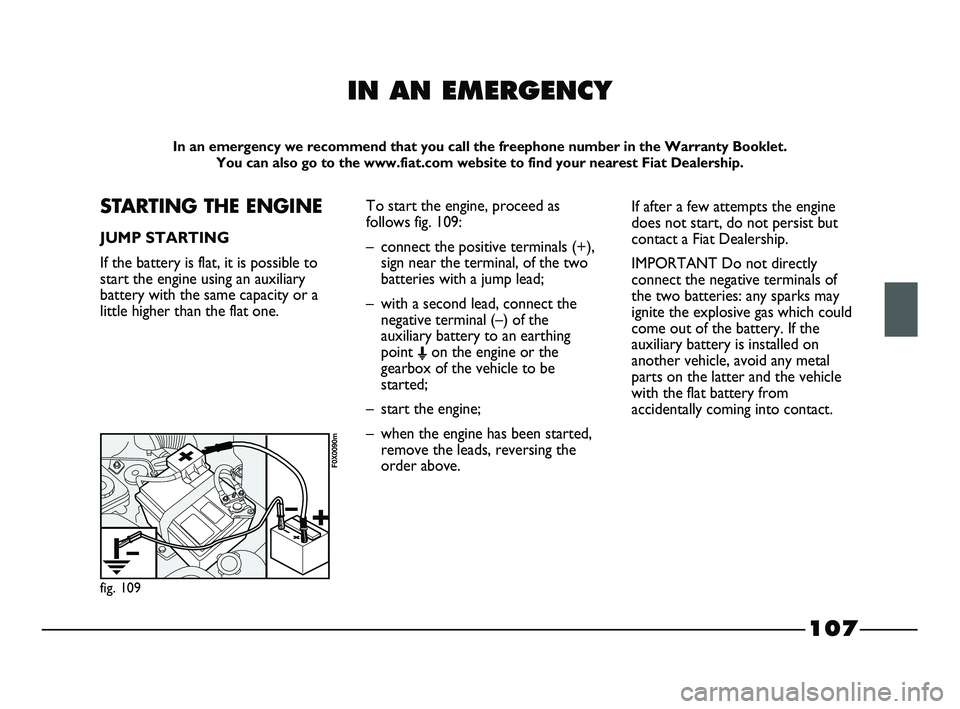
107
IN AN EMERGENCY
In an emergency we recommend that you call the freephone number in the Warranty Booklet.
You can also go to the www.fiat.com website to find your nearest Fiat Dealership.
STARTING THE ENGINE
JUMP STARTING
If the battery is flat, it is possible to
start the engine using an auxiliary
battery with the same capacity or a
little higher than the flat one.
fig. 109
F0X0090m
To start the engine, proceed as
follows fig. 109:
– connect the positive terminals (+),
sign near the terminal, of the two
batteries with a jump lead;
– with a second lead, connect the
negative terminal (–) of the
auxiliary battery to an earthing
point
Eon the engine or the
gearbox of the vehicle to be
started;
– start the engine;
– when the engine has been started,
remove the leads, reversing the
order above.If after a few attempts the engine
does not start, do not persist but
contact a Fiat Dealership.
IMPORTANT Do not directly
connect the negative terminals of
the two batteries: any sparks may
ignite the explosive gas which could
come out of the battery. If the
auxiliary battery is installed on
another vehicle, avoid any metal
parts on the latter and the vehicle
with the flat battery from
accidentally coming into contact.
107-132 STRADA LUM GB 1ed 9-01-2012 14:52 Pagina 107
Page 110 of 187
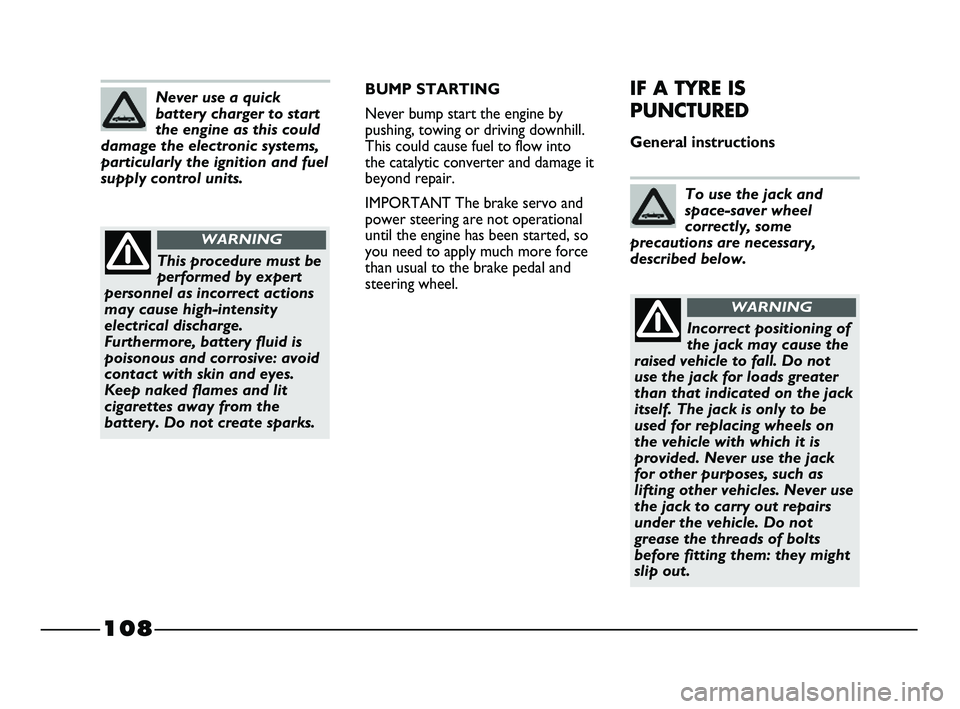
108
BUMP STARTING
Never bump start the engine by
pushing, towing or driving downhill.
This could cause fuel to flow into
the catalytic converter and damage it
beyond repair.
IMPORTANT The brake servo and
power steering are not operational
until the engine has been started, so
you need to apply much more force
than usual to the brake pedal and
steering wheel.IF A TYRE IS
PUNCTURED
General instructions
To use the jack and
space-saver wheel
correctly, some
precautions are necessary,
described below.
Never use a quick
battery charger to start
the engine as this could
damage the electronic systems,
particularly the ignition and fuel
supply control units.
Incorrect positioning of
the jack may cause the
raised vehicle to fall. Do not
use the jack for loads greater
than that indicated on the jack
itself. The jack is only to be
used for replacing wheels on
the vehicle with which it is
provided. Never use the jack
for other purposes, such as
lifting other vehicles. Never use
the jack to carry out repairs
under the vehicle. Do not
grease the threads of bolts
before fitting them: they might
slip out.
WARNING
This procedure must be
performed by expert
personnel as incorrect actions
may cause high-intensity
electrical discharge.
Furthermore, battery fluid is
poisonous and corrosive: avoid
contact with skin and eyes.
Keep naked flames and lit
cigarettes away from the
battery. Do not create sparks.
WARNING
107-132 STRADA LUM GB 1ed 9-01-2012 14:52 Pagina 108
Page 111 of 187
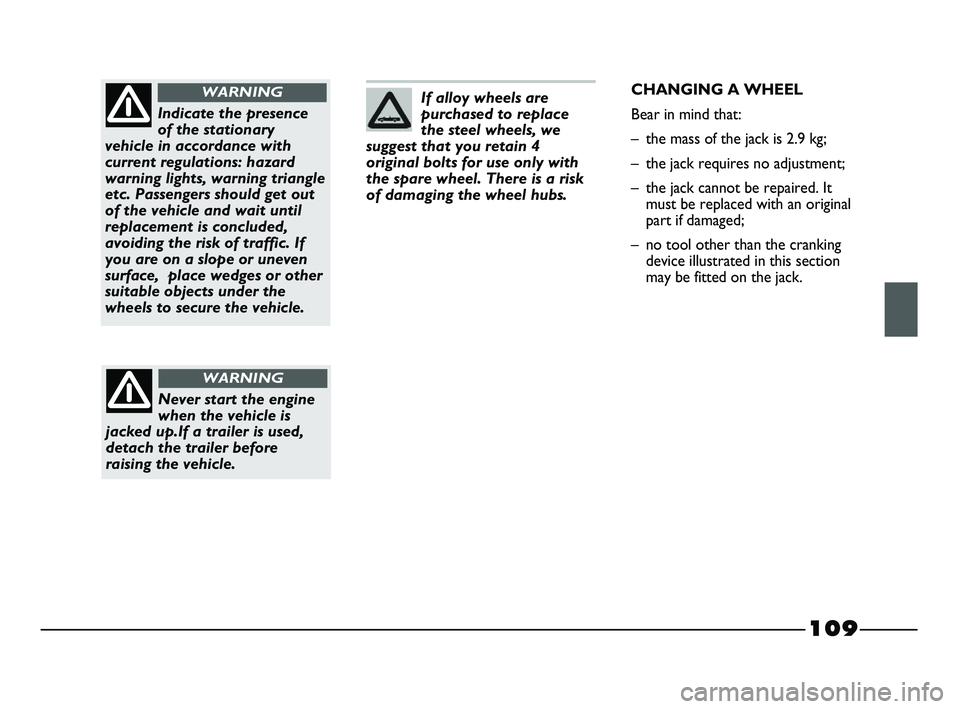
109
If alloy wheels are
purchased to replace
the steel wheels, we
suggest that you retain 4
original bolts for use only with
the spare wheel. There is a risk
of damaging the wheel hubs.
Indicate the presence
of the stationary
vehicle in accordance with
current regulations: hazard
warning lights, warning triangle
etc. Passengers should get out
of the vehicle and wait until
replacement is concluded,
avoiding the risk of traffic. If
you are on a slope or uneven
surface, place wedges or other
suitable objects under the
wheels to secure the vehicle.
WARNINGCHANGING A WHEEL
Bear in mind that:
– the mass of the jack is 2.9 kg;
– the jack requires no adjustment;
– the jack cannot be repaired. It
must be replaced with an original
part if damaged;
– no tool other than the cranking
device illustrated in this section
may be fitted on the jack.
Never start the engine
when the vehicle is
jacked up.If a trailer is used,
detach the trailer before
raising the vehicle.
WARNING
107-132 STRADA LUM GB 1ed 9-01-2012 14:52 Pagina 109
Page 124 of 187
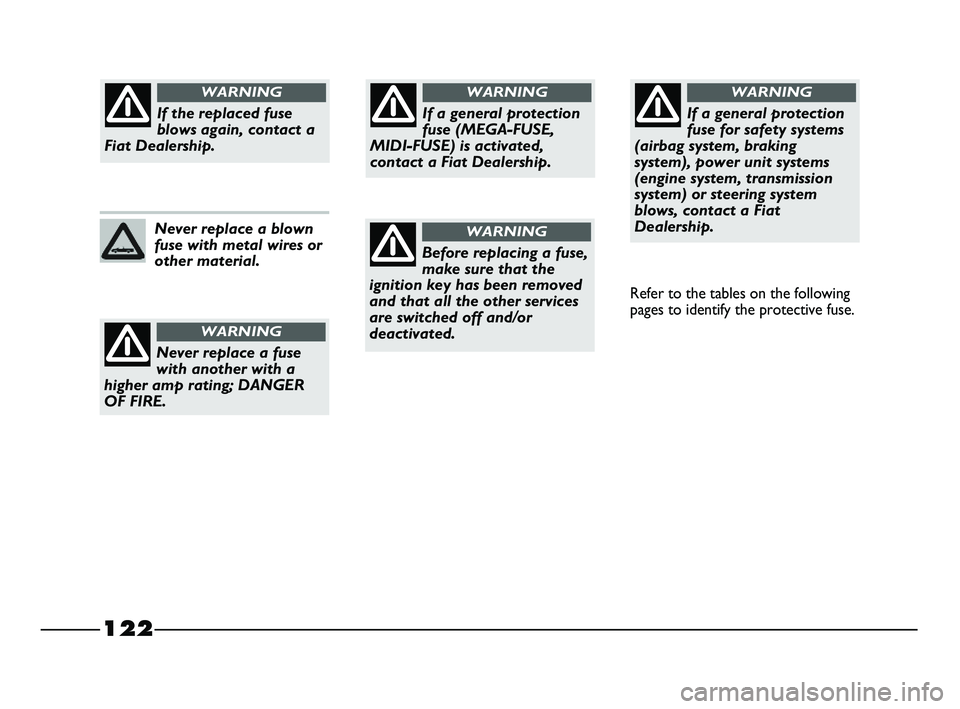
122
If a general protection
fuse (MEGA-FUSE,
MIDI-FUSE) is activated,
contact a Fiat Dealership.
WARNING
Before replacing a fuse,
make sure that the
ignition key has been removed
and that all the other services
are switched off and/or
deactivated.
WARNING
If a general protection
fuse for safety systems
(airbag system, braking
system), power unit systems
(engine system, transmission
system) or steering system
blows, contact a Fiat
Dealership.
WARNING
Refer to the tables on the following
pages to identify the protective fuse.
Never replace a blown
fuse with metal wires or
other material.
If the replaced fuse
blows again, contact a
Fiat Dealership.
WARNING
Never replace a fuse
with another with a
higher amp rating; DANGER
OF FIRE.
WARNING
107-132 STRADA LUM GB 1ed 9-01-2012 14:52 Pagina 122
Page 126 of 187
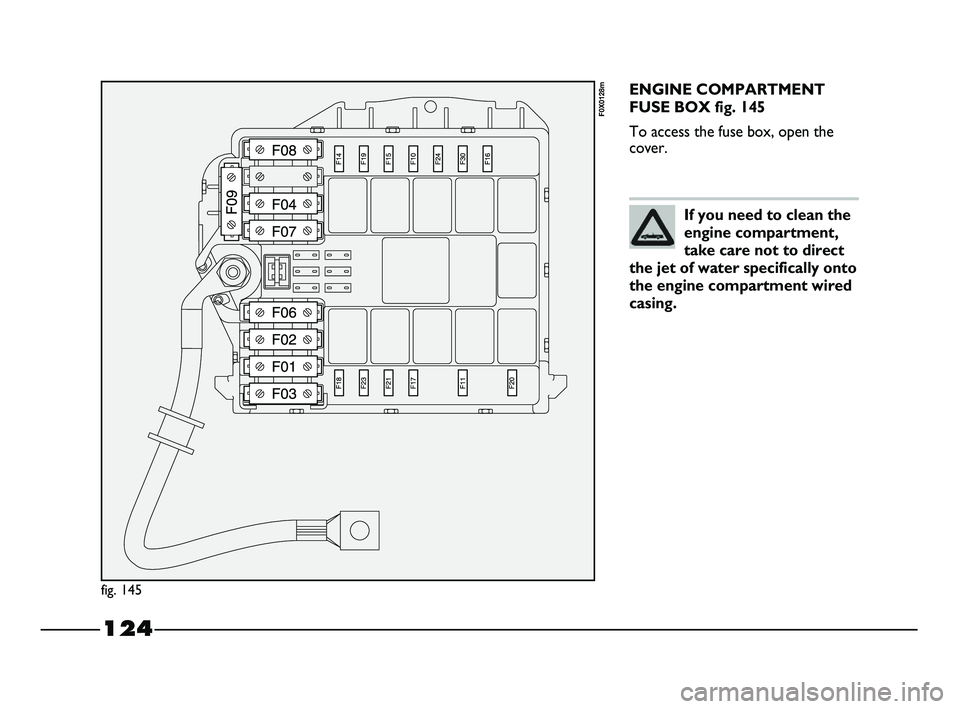
124
ENGINE COMPARTMENT
FUSE BOX fig. 145
To access the fuse box, open the
cover.
fig. 145
F0X0128m
If you need to clean the
engine compartment,
take care not to direct
the jet of water specifically onto
the engine compartment wired
casing.
107-132 STRADA LUM GB 1ed 9-01-2012 14:52 Pagina 124